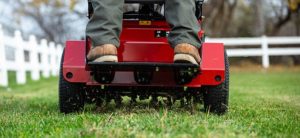Watering the lawn is trickier than most people realize. Even with an automated sprinkler system, it can be difficult to strike that perfect balance between under-watering and over-watering the grass. This is especially true once you take seasonal and regional issues into consideration. After all, what works in Georgia in the summer won’t necessarily apply to Utah in the spring.
Although you should always consult a specialist in your area to set up a truly accurate course of landscaping care, this general guide to seasonal watering should give you an idea of where to start.
Cool-Season Grasses
Cool-season grasses are those that can survive hot summers and freezing winters. They’re mostly found in the northern regions of the United States, and the bulk of their growth takes place in spring and fall.
Spring: Most cool-season regions experience heavy rainfall in the spring, which means you won’t water your lawn as often or as much. Spring is when the grass will do most of its growing since it’s awakening from winter hibernation and taking advantage of all the natural moisture.
You may need to water if you are experiencing less-than-average rainfall or if your lawn is covered in areas (because of trees or other growth). As temperatures rise, you may need to start watering more frequently.
Summer: By the time June hits, your lawn should be getting 1-inch of water per week (from both rainfall and your watering). Your grass will stay green for as long as you maintain this water level. Rising temperatures and lawns in direct sunlight may require watering more often and on a different schedule. It’s best to water cool-season grasses early in the morning so that the grass holds its moisture for longer.
In especially dry summers, maintaining this much water can be difficult—especially if you live somewhere with water restrictions. Fortunately, it’s okay to let your cool-season grass turn dry and brown if needed. This doesn’t mean your grass is dead; it’s merely dormant. It might not look great, but growth should pick up again in the fall.
Fall: Fall tends to be less wet than spring but not as hot as summer, so you can typically cut your watering regimen in half. You’ll still want to maintain a healthy level of moisture, especially if you’ll be doing any seeding or planting at this time.
By the time temperatures are below freezing overnight, you can stop watering for the year. The grass will go into dormancy until spring hits and the cycle starts all over again.
Warm-Season Grasses
Warm-season grasses thrive in tropical regions, where temperatures are high and there is a lot of natural moisture in the air. Unlike cool-season grasses, most of the growth will take place in the heat of the summer. During fall and winter, the grass will turn brown and lie dormant until spring.
Late Winter/Early Spring: Spring comes early in tropical regions, so expect the growth cycle to start sometime in January or February. Depending on how much humidity your region is experiencing, this may mean you’ll need to start watering early on.
Spring: By the time May hits, your lawn should be getting between 1 and 1.25 inches of moisture every week. This number includes both the watering you do at home and natural precipitation, so bear in mind what’s happening in your region regarding the weather.
Summer: Your grass is likely to flourish during the summer with or without your assistance. The best thing you can do during this time is paying attention to local conditions. If it’s been an abnormally dry year, you may have to do some watering; however, most homeowners will find that warm-season grass performs well in an atypical year.
Fall: Come September, it’s time to reduce the amount of watering you do. As rains increase and temperatures drop, chances are your lawn is going to get more water than it needs—not less.
Winter: Although your lawn may be dormant by the time winter hits, a lawn that’s been recently seeded or is continuing to thrive may need watering during November and December. This should be done to supplement any natural rainfall.
Remember, every lawn and every region is different, so it’s best to tailor your watering schedule to your climate and grass species. Contact a local expert and come up with a plan of action. Your lawn will thank you!
SHARE





